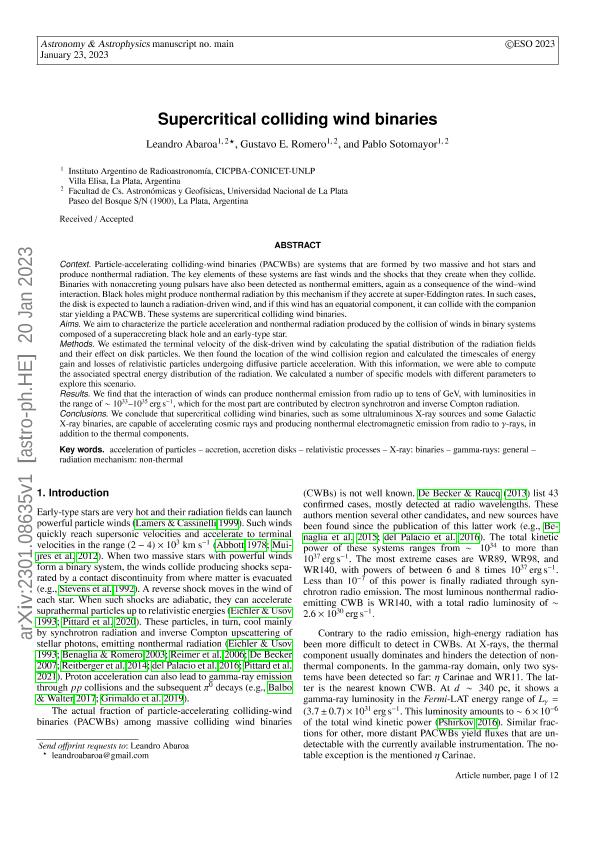Mostrar el registro sencillo del ítem
dc.contributor.author
Abaroa, Leandro

dc.contributor.author
Romero, Gustavo Esteban

dc.contributor.author
Sotomayor Checa, Pablo Omar

dc.date.available
2023-11-14T15:09:51Z
dc.date.issued
2023-03
dc.identifier.citation
Abaroa, Leandro; Romero, Gustavo Esteban; Sotomayor Checa, Pablo Omar; Supercritical colliding wind binaries; EDP Sciences; Astronomy and Astrophysics; 671; A9; 3-2023; 1-12
dc.identifier.issn
0004-6361
dc.identifier.uri
http://hdl.handle.net/11336/218057
dc.description.abstract
Context. Particle-accelerating colliding-wind binaries (PACWBs) are systems that are formed by two massive and hot stars and produce nonthermal radiation. The key elements of these systems are fast winds and the shocks that they create when they collide. Binaries with nonaccreting young pulsars have also been detected as nonthermal emitters, again as a consequence of the wind- wind interaction. Black holes might produce nonthermal radiation by this mechanism if they accrete at super-Eddington rates. In such cases, the disk is expected to launch a radiation-driven wind, and if this wind has an equatorial component, it can collide with the companion star yielding a PACWB. These systems are supercritical colliding wind binaries. Aims. We aim to characterize the particle acceleration and nonthermal radiation produced by the collision of winds in binary systems composed of a superaccreting black hole and an early-type star. Methods. We estimated the terminal velocity of the disk-driven wind by calculating the spatial distribution of the radiation fields and their effect on disk particles. We then found the location of the wind collision region and calculated the timescales of energy gain and losses of relativistic particles undergoing diffusive particle acceleration. With this information, we were able to compute the associated spectral energy distribution of the radiation. We calculated a number of specific models with different parameters to explore this scenario. Results. We find that the interaction of winds can produce nonthermal emission from radio up to tens of GeV, with luminosities in the range of ∼1033- 1035 erg s-1, which for the most part are contributed by electron synchrotron and inverse Compton radiation. Conclusions. We conclude that supercritical colliding wind binaries, such as some ultraluminous X-ray sources and some Galactic X-ray binaries, are capable of accelerating cosmic rays and producing nonthermal electromagnetic emission from radio to γ-rays, in addition to the thermal components.
dc.format
application/pdf
dc.language.iso
eng
dc.publisher
EDP Sciences

dc.rights
info:eu-repo/semantics/openAccess
dc.rights.uri
https://creativecommons.org/licenses/by-nc-sa/2.5/ar/
dc.subject
ACCELERATION OF PARTICLES
dc.subject
ACCRETION, ACCRETION DISKS
dc.subject
GAMMA RAYS: GENERAL
dc.subject
RADIATION MECHANISMS: NON-THERMAL
dc.subject
RELATIVISTIC PROCESSES
dc.subject
X-RAYS: BINARIES
dc.subject.classification
Astronomía

dc.subject.classification
Ciencias Físicas

dc.subject.classification
CIENCIAS NATURALES Y EXACTAS

dc.title
Supercritical colliding wind binaries
dc.type
info:eu-repo/semantics/article
dc.type
info:ar-repo/semantics/artículo
dc.type
info:eu-repo/semantics/publishedVersion
dc.date.updated
2023-11-13T15:51:13Z
dc.journal.volume
671
dc.journal.number
A9
dc.journal.pagination
1-12
dc.journal.pais
Francia

dc.description.fil
Fil: Abaroa, Leandro. Universidad Nacional de La Plata; Argentina. Provincia de Buenos Aires. Gobernación. Comisión de Investigaciones Científicas. Instituto Argentino de Radioastronomía. Consejo Nacional de Investigaciones Científicas y Técnicas. Centro Científico Tecnológico Conicet - La Plata. Instituto Argentino de Radioastronomía; Argentina
dc.description.fil
Fil: Romero, Gustavo Esteban. Provincia de Buenos Aires. Gobernación. Comisión de Investigaciones Científicas. Instituto Argentino de Radioastronomía. Consejo Nacional de Investigaciones Científicas y Técnicas. Centro Científico Tecnológico Conicet - La Plata. Instituto Argentino de Radioastronomía; Argentina. Universidad Nacional de La Plata; Argentina
dc.description.fil
Fil: Sotomayor Checa, Pablo Omar. Universidad Nacional de La Plata; Argentina. Provincia de Buenos Aires. Gobernación. Comisión de Investigaciones Científicas. Instituto Argentino de Radioastronomía. Consejo Nacional de Investigaciones Científicas y Técnicas. Centro Científico Tecnológico Conicet - La Plata. Instituto Argentino de Radioastronomía; Argentina
dc.journal.title
Astronomy and Astrophysics

dc.relation.alternativeid
info:eu-repo/semantics/altIdentifier/doi/http://dx.doi.org/10.1051/0004-6361/202245285
dc.relation.alternativeid
info:eu-repo/semantics/altIdentifier/url/https://www.aanda.org/articles/aa/full_html/2023/03/aa45285-22/aa45285-22.html
Archivos asociados
